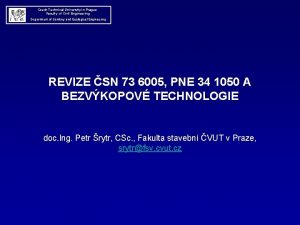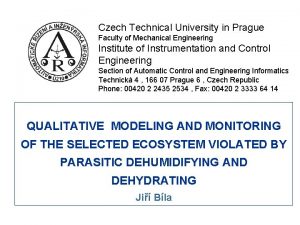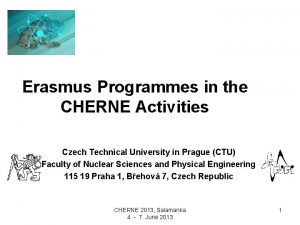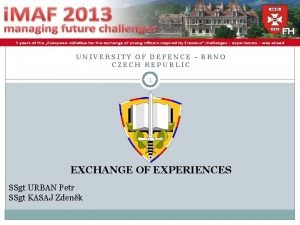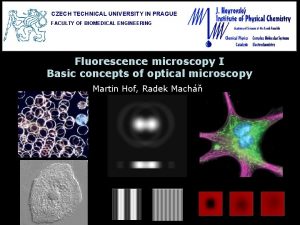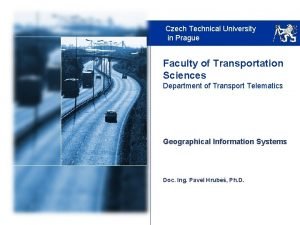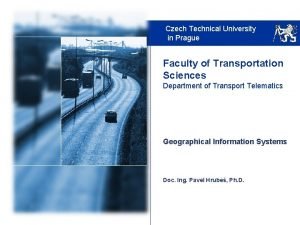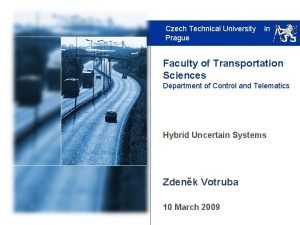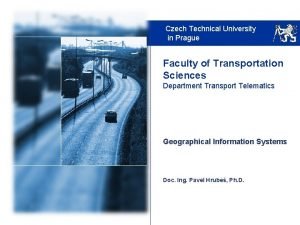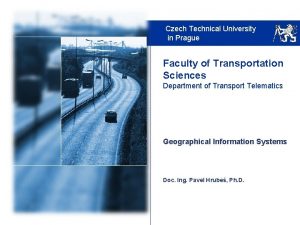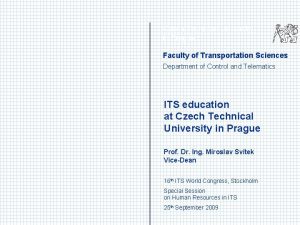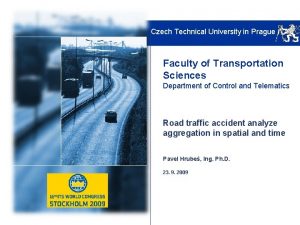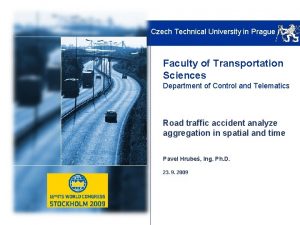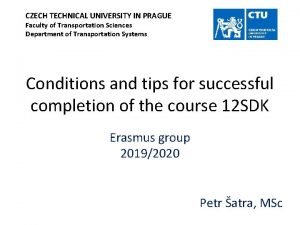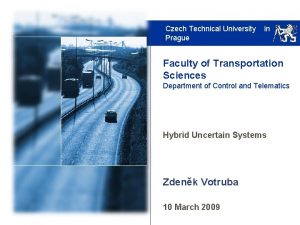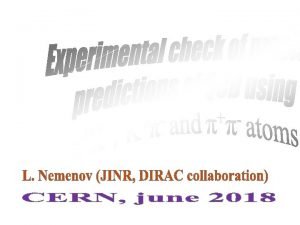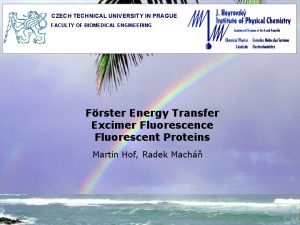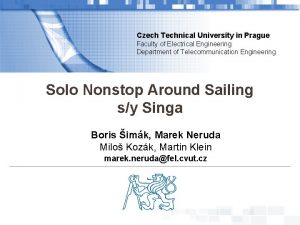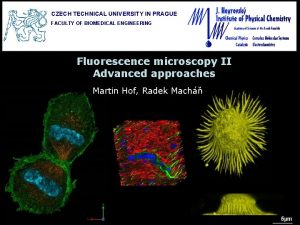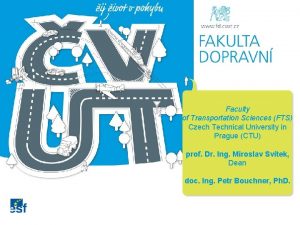Czech Technical University in Prague Faculty of Transportation





























- Slides: 29

Czech Technical University in Prague Faculty of Transportation Sciences Department of Control Engineering and Telematics Architecture of the Transport Telematics Systems Doc. Dr. Ing. Miroslav Svítek Head of Laboratory of Telematics

Content Introduction ITS Architecture Theory • • Methodology of ITS Architecture Creation User Requirements and System Parameters Definition Synchronization in time, parameter, protocol, etc. Design Methodology based on ITS architecture Physical realization of ITS subsystems Use Case Subsystem - On-board Unit (OBU) Economical Analysis of ITS Architecture Benefits Management of ITS Systems • • Relation Between ITS Model and Reality New Services for ITS management Pilot Evaluation of ITS Architecture • Information System for Monitoring and Control of Dangerous Goods Transport with help of GNSS (Galileo) Conclusion Czech Technical University in Prague - Faculty of Transportation Sciences Department of Control Engineering and Telematics

Project supported by Ministry of Transport of the Czech Republic ITS architecture of the Czech Republic • is solved within the project „ITS in transporttelecommunication conditions of the Czech Republic (802 -210 -108) supported by Ministry of Transport • comes from KAREN, FRAME, ACTIF projects • time schedule 2001 - 2005 Czech Technical University in Prague - Faculty of Transportation Sciences Department of Control Engineering and Telematics

ITS architecture – process analysis F 2 F 3 IVM G 3 The architecture defines the basic arrangement in (abstract) G 2 space: Management 1 Reference architecture – defines main subsystems, basic actors, Management 2 relation with system environment Management 3 Functional architecture – defines main subsystem functions and applications 3 2 1 F 1 Information architecture – defines requirements on collection, transfer and processing of information Management Center • The system component carries the Physical architecture – defines requirements on physical subsystems implicit system function (equipments) releasing G 1 • The processes are defined by chaining factor: GOODS Communication architecture – describes subsystems for transfer of of system components through the releasing information with respect tolinks physical architecture factor: DRIVER – allocates the human function into • The application is defined as a set of GNSS locator Organisational architecture Czech system Technical components University in Prague - Faculty of Transportation Sciences Vehicle strong processes Interface Department of Control Engineering and Telematics IVM. . In Vehicle Management

ITS architecture – process analysis F 2 F 3 G 3 matrix, etc. ) G 2 (risk analysis, risk classification, risk tolerability Safety IVM Management 1 Reliability (the ability to perform required function under given Management 2 conditions for a given time interval) Management 3 Availability (the ability to perform required function at the initialisation of the intended operation) 3 Integrity (the ability to provide timely and valid alerts to the user when a Management Center system must not be used for the intended operation) 2 1 F 1 Continuity (the abilityreleasing to perform required function without non. G 1 factor: GOODS scheduled interruption during the intended operation) releasing factor: DRIVER Accuracy (the degree of conformance between. IVM. . In Vehicle Management a platform’s true GNSS locatorparameter and its estimated value) Czech Technical University in Prague - Faculty of Transportation Sciences Vehicle Department of Control Engineering and Telematics Interface

ITS architecture - synchronization of information Parameter sychronization • data elements definition together with its attributes (data model for e. g. geographical database, etc. ) for whole ITS • system parameters assigned to each data element (assurance, reliability, etc. ) • results: • the ITS data registry covering information about each data element (current state) together with its standardised value (future state) • preferably using of standardized data model with required system parameters for the whole set of ITS applications (future state) • advantages: • knowledge of data elements in ITS (current and future state), collecting data fulfilling the requirements of the set of ITS applications (data sharing, data interoperability) • Cost saving for administration and service of duplicated databases, data transformation, etc. Czech Technical University in Prague - Faculty of Transportation Sciences Department of Control Engineering and Telematics

ITS architecture - synchronization of information System 1 System 2 Electronic fee collection Freight, fleet management ITS data register Sensors of position Accuracy 5 m 1 2 Accuracy 10 m Czech Technical University in Prague - Faculty of Transportation Sciences Department of Control Engineering and Telematics

ITS architecture - synchronization of information System 1 System 2 Electronic fee collection Freight, fleet management ITS data register Sensor of Accuracy 5 m position Sensors of position 1 2 Accuracy 10 m Czech Technical University in Prague - Faculty of Transportation Sciences Department of Control Engineering and Telematics

ITS architecture - synchronization of information Time synchronization • identification of time requirements (sample frequency, maximal time delay, etc. ) for all data collected, transmitted and processed by each ITS application • time requirements merging and forming the harmonogram for all ITS applications • definition of data packages (buffers) that are collected, transmitted and processed in the same time interval • results: • the design of databases, interfaces, etc. covering the time requirements of all ITS applications • the design of data transmition buffer together with its transition time schedule • advantages: • decreasing of the transmited data value between subsystems (data package could be better zipped) • Increasing of the dynamical parameters of ITS applications (better systém stability, etc. ) Czech Technical University in Prague - Faculty of Transportation Sciences Department of Control Engineering and Telematics

Time synchronization System 1 1 x per hour F 1 F 2 F 3 System 2 5 x per hour 1 x per minute Czech Technical University in Prague - Faculty of Transportation Sciences Department of Control Engineering and Telematics G 1 G 2 G 3

Time synchronization Buffer System 1 System 2 1 x per hour F 1 5 x per hour minimal period F 2 (1 x per minute) 1 x per minute F 3 Info 1 Info 2 Info 3 Czech Technical University in Prague - Faculty of Transportation Sciences Department of Control Engineering and Telematics G 1 G 2 G 3

ITS architecture - synchronization of information Protocol synchronization • system requirements assigned to transmitted messages definition of transmision protocols in ITS (current and future state) together with its performance parameters • results: • • technical standards CEN, ISO • advantages: • definition of optimised protocol for all ITS applications with respect to parameter and time requirements Czech Technical University in Prague - Faculty of Transportation Sciences Department of Control Engineering and Telematics

Protocol synchronization Buffer System 1 System 2 F 1 G 1 minimal period F 2 G 2 (1 x per minute) F 3 G 3 Info 1 Info 2 Info 3 e. g. Personal data (electronic signature needed) Czech Technical University in Prague - Faculty of Transportation Sciences Department of Control Engineering and Telematics

Methodology of ITS system design • System parameters assigned to each strong process and its decomposition into individual components • The table of different performance parameters dedicated to each individual component • Definition of optimisation criteria for performance parameters integration (the selection of most exacting criteria of all representative processes, weighted average of all the most exacting criteria) Czech Technical University in Prague - Faculty of Transportation Sciences Department of Control Engineering and Telematics

Methodology of ITS system design Design of ITS components (OBU, telecommunication environment, processing center, local components - call centers, etc. ) design of universal components fulfilling the most exacting performance parameters f 1, f 2 design of modular components – the addition of another module entails the increase of performance parameters f 1 f 3 design of several component classes according to a set of performance parameters f 1 -fn kernel Czech Technical University in Prague - Faculty of Transportation Sciences Department of Control Engineering and Telematics fn

ITS architecture – Physical realization of ITS components (subsystems) based on ITS architecture • • Definition of all parameters used in component (subsystem) together with its atributes (sample freguency, acuracy, representation, etc. ) Definition of unified SW modules available for all proceses (functions, databases and conditions) Definition of management taking into account all system parameters (safety, priority, etc. ) Definition of processes/ applications using unified functions, databases and conditions (development kit) Applications and Processes Hardware n 1 Platform M A N A G E M E N T functions middleware kernel 1 databases conditions CORBA, J 2 EE, J 2 SE, J 2 ME, . net, atd. SW drivers, interfaces, operating system n Czech Technical University in Prague - Faculty of Transportation Sciences Department of Control Engineering and Telematics

Management of ITS systems - model and reality M MODEL OF ITS SYSTEM A N A ITS architecture ITS standards ITS data register ITS interface ITS databases G E M REAL ITS SYSTEM E N T ITS aplikacations Czech Technical University in Prague - Faculty of Transportation Sciences Department of Control Engineering and Telematics

ITS architecture – Information data flow Input data flows to functional area 5 from terminators Data flows between functional areas Outputs data flows from functional area 5 to Terminators Czech Technical University in Prague - Faculty of Transportation Sciences Department of Control Engineering and Telematics

ITS architecture – Information data flow Imput data flows from other functions Input data flows from terminators Output data flows to other functions Output data flows to terminators Czech Technical University in Prague - Faculty of Transportation Sciences Department of Control Engineering and Telematics

ITS architecture – physical architecture Centre subsystems • • • Mainterance Management System Parking Management System Public Transport Management System Tool Administration System Trafic Management System • • Travel Coordination System Archived Data Management System Commercial Vehicle Administration System Emergency Management System Feet Management System Freight Management System Information Service Provider System Law Enforcement System Communication interface Travellers subsystems • Kiosk Systems • Personal Device system Vehicles subsystems • • • Commercial Vehicle System Emergency Vehicle System Freight Equipment System Maintenance Vehicle System Public Transport Vehicle System Personal Vehicle System Infrastructure subsystems • Commercial Vehicle Check System • Tool Collection System • Parking Facilities System • Roadway System Czech Technical University in Prague - Faculty of Transportation Sciences Department of Control Engineering and Telematics

ITS Data Register The definition of data registry (ISO/IEC 11179 ) • An information resource kept by a registration authority that describes the meaning form of data elements, including registration identifiers, definitions, names, value domains, metadata and administrative atributes The data registry should manage two types of information • Data and information standards at micro and macro information levels to be used in data management • Information about current (legacy) data elements METADATA Name of element Definition Format Value ID Airport unique kode assigned to Airport char (4) LKPR Czech Technical University in Prague - Faculty of Transportation Sciences Department of Control Engineering and Telematics

ITS Data Register Benefit of data registry: • • Data quality and access – reducing the ambiguity about similar data defined differently across systems Interoperability – today, system interfaces are customized between pairs of systems (expensive to build and maintain, inflexible) – solution is data structure definition Cost effectiveness – constrained budget can be used when data services can serve multiple systems rather than when each system develops its own data services locally Flexibility – common data services developed with automated tools allows systemwide access to metadata and the data behind them more easily and efficiently Data elements from Actual Application ITS data register Standardized METADATA Association of metadata Application 1 Application 2 Actual Application Czech Technical University in Prague - Faculty of Transportation Sciences Department of Control Engineering and Telematics

ITS Standards ITS standards (CEN, ISO) could be linked with • • ITS architecture: functions, interfaces, physical subsystems, communication links ITS data registry: data model, transmission messages The role of ITS standards could be summarized: • • instrument for time, parameter and protocol synchronization added value for ITS architecture and ITS data registry Czech Technical University in Prague - Faculty of Transportation Sciences Department of Control Engineering and Telematics

New Management Services of ITS System • Optimisation of telecommunication environment between subsystems • Maximal exploitation of already existing ITS subsystems (typical national ones) • Optimal geographical distribution of ITS subsystems (hierarchical structure, sharing of control centers) • Unified implementation of software and hardware components within ITS system (charge deduction for multi-licences) • Recommendation of favourable investment strategy • Protocol definitions for the whole set of ITS applications • Continual comparison between ITS model and the reality Czech Technical University in Prague - Faculty of Transportation Sciences Department of Control Engineering and Telematics

Economical Analysis of ITS Architecture Information Collection 16% Telematics system with designed architecture Information Processing 64% Telematics system without designed architecture Information Transmission 20% Information Collection 15% Information Processing 36% Czech Technical University in Prague - Faculty of Transportation Sciences Department of Control Engineering and Telematics Information Transmission 49%

Projects supported by Ministry of Transport of the Czech Republic Information system for monitoring and control of dangerous goods • is one of the pilot applications prepared within project „Involvement of the Czech Republic into Galileo Project“ (802 -210 -112) supported by Ministry of Transport • is pilot application of using the ITS architecture for practical design of selected telematics application • time schedule 2001 - 2006 Czech Technical University in Prague - Faculty of Transportation Sciences Department of Control Engineering and Telematics

Monitoring and Control of Dangerous Goods Transport telematics means (OBU of rescue vehicles, etc. ) IS Rescue Services E X T E R N A L I N F O R M A T I O N IS Public Authority IS Custom Authority other companies e. g. insurance Management subsystem • Route selections and dangerous transports tracks monitoring • Emergency call in case of accidents, accident location • Processing of available information (models of contamination, traffic information, etc. ) • Instruction for intervention • Re-routing of traffic, warning the public, etc. • Accident impact evaluations ITS Infrastructure management ITS Forwarding Companies ITS Transport Operators other companies e. g. meteo telematics means (detectors, actors, OBU, ID, etc. ) Czech Technical University in Prague - Faculty of Transportation Sciences Department of Control Engineering and Telematics

Conclusion • The design of telematics applications based on user needs • Achievement of the interoperability between individual telematics applications • Synchronisation in terms of time and position of all information systems of the carrier, forwarder, infrastructure manager and also ITS services in all architecture layers of the ITS system • Maximum use of available infrastructure by all telematics applications while keeping performance parameters on individual telematics applications • Transfer of the intelligence from higher layers of the ITS system to the in-vehicle mobile unit or to a unit located on the object of the transportation • Significant economical impacts of systematic solution according to presented methodology Czech Technical University in Prague - Faculty of Transportation Sciences Department of Control Engineering and Telematics

Thank you for attention More information: WWW. LT. FD. CVUT. CZ Czech Technical University in Prague - Faculty of Transportation Sciences Department of Control Engineering and Telematics
 Faculty of civil engineering ctu prague
Faculty of civil engineering ctu prague Czech technical university in prague civil engineering
Czech technical university in prague civil engineering Czech technical university mechanical engineering
Czech technical university mechanical engineering Ctu prague erasmus
Ctu prague erasmus University of kragujevac faculty of technical sciences
University of kragujevac faculty of technical sciences University of chemistry and technology, prague
University of chemistry and technology, prague University of chemistry and technology in prague
University of chemistry and technology in prague Is.muni
Is.muni University of defence czech republic
University of defence czech republic South bohemia university
South bohemia university Czech tech university
Czech tech university Koda auto
Koda auto University of split faculty of maritime studies
University of split faculty of maritime studies University of bridgeport engineering
University of bridgeport engineering University of bridgeport computer engineering
University of bridgeport computer engineering Hubert kairuki memorial university faculty of medicine
Hubert kairuki memorial university faculty of medicine Solid thyroid nodule
Solid thyroid nodule King abdulaziz university faculty of medicine
King abdulaziz university faculty of medicine Florida state university cs faculty
Florida state university cs faculty Faculty of business and economics mendel university in brno
Faculty of business and economics mendel university in brno Singularity executive program
Singularity executive program Agnes csaki semmelweis
Agnes csaki semmelweis Masaryk university medical faculty
Masaryk university medical faculty Feup university of porto
Feup university of porto Webkredit cuni
Webkredit cuni Faculty of veterinary medicine cairo university logo
Faculty of veterinary medicine cairo university logo Faculty of law of the university of zagreb
Faculty of law of the university of zagreb University of montenegro faculty of law
University of montenegro faculty of law University of cologne faculty of management
University of cologne faculty of management Leading university tuition fees
Leading university tuition fees

